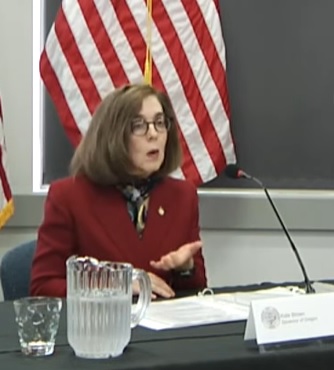“Schools are not super spreader sitesâ€
Teachers and administrators are losing their minds after Governor Kate Brown
announced a relaxing of the guidelines for schools to open. According to Brown, 130,000 students will be able to start back to school for in person instruction throughout the state. The new metrics bring Oregon into alignment with California, and the CDC.
Despite pushback from teachers and administrative staff, who fear catching COVID-19, Colt Gill of the Oregon Department of Education maintains that "schools are not super spreader sites." Teachers are calling upon their union leaders to return to the older metrics, fearful of getting sick.
Yet pressure to return schools to in person teaching, has been mounting. Aside from
lawsuits filed against the Governor, stakeholders, parents, and lawmakers have added to the growing number of individuals, concerned over distance learning models, demanding the return to in person instruction.
In her press conference Friday October 30th, Brown stated "Our updated metrics are based on the latest COVID-19 studies and data, are aligned with CDC recommendations, and bring Oregon in sync with the standards of other states like California,†said Governor Brown. “They also help us meet our priority of returning students to in-person instruction. These metrics still place a very high bar for low case counts to open schools, while at the same time providing more flexibility for our younger students.â€

Brown added that "Schools are at the center of it all: the personnel, teachers, nurses, counselors, librarians, and education support professionals who, every day, build the personal, individual connections with students that are so crucial to their lifelong success.†She also noted that “What is really clear is that schools are not ‘super-spreader’ events.â€
Education accounts for one of the largest budgets in the state of Oregon, and is often the source of contentious, heatedly debated bills like the 2019 long session's
HB 3427, dubbed "The Student Success Act," which allocated money to the general fund by creating a new corporate activity tax. The bill passed with an emergency clause, going into immediate effect, amidst a pandemic, when Oregon businesses were already struggling to survive.
Parents have been disenrolling students at rates far exceeding the 3% cap, needed to maintain funding for each district.
During a recent lawsuit from a Hermiston based school, a policy adviser for Brown “discussed the potential for a 'mass exodus' of children from public schools and emphasized that public schools could suffer a reduction in funding if students disenrolled to obtain education elsewhere."
The timing of this new metric announcement leaves many wondering, if the Brown administration is potentially concerned with
civil unrest. "It's common knowledge, at this point, that counties are gearing up for continued unrest, like we've seen over the past several months here in Portland. Rioters who are predominantly young people, have been given an outlet with these protests, be it violent or peaceful. I'm honestly wondering if this isn't a way to get them back into school, and off Portland streets, in time for the election results?" Says Jenn Williams, who recently switched to homeschooling, after learning about content offered in public schools. "I completely understand why parents are rapidly disengaging from the public school system, and also see how that could really hurt the state's coffers." "Everything else about this pandemic has seemed more political than scientifically based from the start, why would this metric change be anything other than political in nature?" Asks Williams.
--Breeauna Sagdal| Post Date: 2020-10-31 08:33:19 | Last Update: 2020-10-31 09:07:08 |







